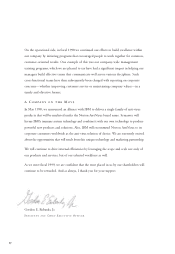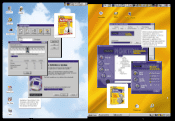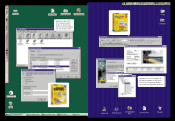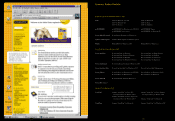Symantec 1998 Annual Report Download - page 18
Download and view the complete annual report
Please find page 18 of the 1998 Symantec annual report below. You can navigate through the pages in the report by either clicking on the pages listed below, or by using the keyword search tool below to find specific information within the annual report.
SYMANTEC CORPORATION
SYMANTEC CORPORATION 23
Gross Margin
Gross margin represents net revenues less
cost of revenues. Cost of revenues consists
primarily of manufacturing expenses, costs
for producing manuals, packaging costs,
royalties paid to third parties under pub-
lishing contracts and amortization and
write-off of capitalized software.
Gross margins increased to 85% of net
revenues in fiscal 1998 from 80% in fiscal
1997 and from 75% in fiscal 1996.
Factors contributing to an increase in
gross margin percentage during fiscal 1998
include reduction of direct material costs
by shifting product media from more
expensive diskettes to lower priced CD-
ROMs and reductions in the size of bound
manuals through a shift in documentation
from paper manuals to electronic manuals
included on CD-ROMs for all of the
Company’s principal products. Additional
reductions occurred in manufacturing
overhead costs due to improved economies
of scale and reductions in capitalized
software amortization and write-offs as
discussed below. In addition, fiscal 1998
royalty revenues from JetForm and
Hewlett-Packard totaling $46 million
had minimal costs of revenue.
The increase in gross margin percent-
age in fiscal 1997 compared to fiscal 1996
was due to a decrease in capitalized soft-
ware amortization and write-offs as
discussed below. In addition, fiscal 1997
royalty revenues from JetForm and
Hewlett-Packard totaling $19 million
had minimal costs of revenue.
Capitalized Software. During fiscal 1998,
accounting standards requiring capitaliza-
tion of certain software development costs
did not materially affect the Company.
During fiscal 1997, Symantec capitalized
approximately $8 million of software deve-
lopment costs, primarily related to net-
work administration technology. Prior to
fiscal 1997, accounting standards requiring
capitalization of certain software develop-
ment costs did not materially affect the
Company, except for amounts capitalized
by Delrina prior to its acquisition by
Symantec in fiscal 1996.
Amortization of capitalized software,
including amortization and write-off of
both purchased product rights and capi-
talized software development expenses,
totaled $1 million, $10 million and $19
million for fiscal 1998, 1997 and 1996, res-
pectively. The decrease in amortization
expense in fiscal 1998 is attributed to the
write-off of approximately $8 million of
unamortized capitalized software and
unamortized purchased software product
rights related to network administration
technology written off as part of the sale
of the networking business unit to Hewlett-
Packard in March 1997. Amortization
and write-off expense in fiscal year 1997
was lower than in 1996 due to capitalized
software write-offs in fiscal 1996 related
to de-emphasized products and Delrina
Windows 3.1 products.
Research and Development Expenses
Research and development expenses rep-
resented 16%, 19% and 21% of net revenues
in fiscal 1998, 1997 and 1996, respetively.
Research and development expend tures
are charged to operations as incurred.
Research and development expenses
increased 3% to $91 million in fiscal 1998
from $89 million in fiscal 1997 as the
result of increased spending on new
product development. The decrease in
research and development expenses as a
percentage of net revenues in fiscal 1998
largely resulted from the Company’s
decision to cease development of certain
software products no longer actively mar-
keted by Symantec. Another contributing
factor was the elimination of certain net-
work administration technology develop-
ment due to the sale of Symantec’s net-
working business unit to Hewlett-Packard
during fiscal 1997.
Research and development expenses
decreased 6% to $89 million in fiscal 1997
from $95 million in fiscal 1996 due pri-
marily to decreased product development
efforts resulting from the Company’s de-
cision to cease developing certain sofware
products and an increase in the capital-
ization of software development costs,
including approximately $8 million related
to network administration technology. In
addition, a $2 million research and develop-
ment expense reimbursement was received
from Hewlett-Packard in fiscal 1997 under
the previously mentioned technology sale
agreement, which further reduced research
and development expenses in fiscal 1997.
Sales and Marketing Expenses
Sales and marketing expenses increased
18% to $261 million, or 45% of net revenues
in fiscal 1998 from $221 million, or 47%
of net revenues, in fiscal 1997. The increase
in sales and marketing expenses in fiscal
1998 as compared to fiscal 1997 is primarily
related to increased international sales
and marketing activities. North American
sales and marketing activities during fis-
cal 1998 decreased as a percentage of net
revenues as compared to fiscal 1997 due to
the elimination of activities related to the
electronic forms and network adminis-
tration software technologies and products
which were sold in fiscal 1997.
Sales and marketing expenses decreased
4% to $221 million, or 47% of net revenues,
in fiscal 1997 from $230 million, or 52% of
net revenues, in fiscal 1996. The decrease
in sales and marketing expenses in fiscal
1997 as compared to fiscal 1996 was due
primarily to the elimination of duplica-
tive sales and marketing expenses as a
result of the acquisition of Delrina by
Symantec and the elimination of sales
and marketing expenses related to the
electronic forms software products which
were sold in fiscal 1997. Reductions in
expenditures for products no longer
22
Net Revenues
Net revenues increased 22% from $472
million in fiscal 1997 to $578 million in fis-
cal 1998. Net revenues increased 6% from
$445 million in fiscal 1996 to $472 million in
fiscal 1997. Revenue growth in fiscal 1998
was largely due to sales of Windows 95 and
Windows NT versions of the Company’s
principal products, as well as introduc-
tions of new products, growth in inter-
national sales outside of North America
and royalty and revenue streams from the
sale of certain technologies and product
lines to third-party computing companies.
Product Groups. During fiscal 1998 and
1997, Symantec experienced increased
net revenues, over the prior fiscal year,
from each of its principal product groups:
Security and Assistance and Remote
Productivity Solutions.
The Security and Assistance business
unit is dedicated to being indispensable
to customers’ daily use of computers by
increasing productivity and keeping
computers safe and reliable. The Security
and Assistance business unit comprised
approximately 50% of net revenues for
both fiscal 1998 and 1997 and 45% of net
revenues in fiscal 1996. Increased net rev-
enues for the business unit in fiscal 1998
primarily related to sales of Windows 95,
Windows NT and Macintosh versions of
Norton Utilities, as well as the multi-
platform workstations/servers version of
Norton AntiVirus. New product releases
of CrashGuard Deluxe and Norton
Uninstall also contributed to the fiscal
1998 net revenue increase. Increased net
revenues in fiscal 1997 were primarily
attributable to increases in Norton
AntiVirus revenues over the prior year.
The Remote Productivity Solutions
business unit helps remote professionals
remain productive and work reliably —
anywhere, anytime. The Remote Producti-
vity Solutions business unit comprised
approximately 40% of the Company’s
net revenues for fiscal 1998, and 35% of
net revenues for fiscal 1997 and 1996.
Increased net revenues for the business
unit in fiscal 1998 primarily related to
sales of Windows 95 versions of WinFax
PRO, pcANYWHERE and ACT!.
Increased net revenues in fiscal 1997, over
fiscal 1996, were primarily attributed to
the pcANYWHERE product line.
During fiscal 1998 and 1997, the finan-
cial impact of product price reductions
for certain of Symantec’s principal prod-
ucts was more than offset by the increase
in the volume of products sold, resulting
in increased net revenues.
Internet Tools, Royalties and Other,
which includes products providing an easy-
to-use Java development environment, as
well as revenue streams from the sale of
certain of the Company’s software product
lines and technologies, and revenues from
products nearing the end of their life
cycles, comprised approximately 10%, 15%
and 20% of net revenues for fiscal 1998,
1997 and 1996, respectively. The business
unit’s net revenues decreased in fiscal 1998
and 1997 over the prior fiscal year, largely
as a result of declining sales from products
which Symantec no longer actively develops
or markets. Also contributing to the fiscal
1998 decrease from the prior year was the
fiscal 1997 recognition of $6 million of
non-recurring consulting net revenues.
Also included in Internet Tools,
Royalties and Other are royalties and
other revenue of approximately $46 million
and $19 million recorded in fiscal 1998
and 1997, respectively, which partially off-
set the revenue declines mentioned above.
These royalties and other revenues related
to the sale of certain software products,
technologies and certain tangible assets to
JetForm Corporation (“JetForm”) and the
Hewlett-Packard Company (“Hewlett-
Packard”) during fiscal 1997. Revenues
from these agreements may decline in
fiscal 1999. See Note 12 of Notes to Con-
solidated Financial Statements in Part IV,
Item 14 of this Form 10-K for further dis-
cussion of the technology licensing and
sale transactions. The Java development
tools product line continued to expand in
fiscal 1998, resulting in increased revenues
over fiscal 1997 and maintaining its fiscal
1997 percentage contribution to total net
revenues in fiscal 1998.
International. Net revenues from interna-
tional sales outside of North America were
$186 million and $138 million and repre-
sented 32% and 29% of total net revenues in
fiscal years 1998 and 1997, respectively. The
increase in net revenues was the result of
Symantec’s penetration of new and emerg-
ing markets in Latin America and Asia/
Pacific, as well as increased sales in Europe.
Net revenues from international sales
declined by $4 million in fiscal 1997, from
$142 million in fiscal 1996. This decrease
was due largely to the recognition in fiscal
1996 of approximately $7 million of pre-
viously deferred revenue related to an
acquired company.
Foreign exchange rate fluctuations
during fiscal 1998 and 1997 did not mate-
rially affect annual revenue. The impact
of fluctuations in foreign exchange rates
on international revenues is partially
mitigated by operating expenses incurred
in local currencies.
Product Returns. The Company estimates
and maintains reserves for product returns.
The level of actual product returns and
related product return provisions are
largely a factor of the level of product
sell-in (gross revenue) from normal sales
activity and the replacement of obsolete
quantities with the current version of the
Company’s products. Changes in the levels
of product returns and related product
returns provision are generally offset by
changing levels of gross revenue and, there-
fore, the product return provision did not
have a material impact on reported net
revenues in any period presented.
























